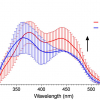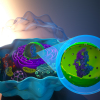Spectroscopy News
This proteomics approach enables the identification of small molecule drug targets in complex proteomes and the analysis of their binding properties across species and drug target classes.
Waveguide-based SERS analysis could allow high-throughput, chip-based screening for protease inhibitors.
Researchers at Texas A&M University have invented a new technology that can drastically reduce the size of instrumentation used for Raman spectroscopy.
The current state-of-the-art IR spectroscopy method can make approximately 1 million observations per second. University of Tokyo researchers have developed a new method about 100× faster.
The French Chemometrics Society award is given in honour of the late Professor Jean-Pierre Huvenne for his early contribution to chemometrics in vibrational spectroscopy in France and is open to PhD students worldwide.
Marine pollutants are taken up by corals directly from seawater as well as through accumulation in their food shows research from KAUST using cavity ring-down spectroscopy. This is the first time the approach has been used to measure pollutant accumulation.
The mass of microplastics in the Atlantic Ocean has been significantly underestimated.
Quantum Design’s partner Moxtek has supplied XRF components for the Perseverance Mars rover.
Nominations for the 2020 Norman Sheppard Award are invited.
Intabio has signed a co-marketing agreement with Agilent Technologies to support development of an integrated iCIEF-MS assay.
Bruker has announced a collaboration with Utrecht University to advance the study of the 3-D structures and interactions of proteins by crosslinking mass spectrometry.
SAMDI mass spectrometry is being used with a “live cell analysis device” to allow cells to be sampled over time, offering a window to responses that evolve.
Fluorescence spectroscopy of biomarkers in urine can track malignant melanoma progression or treatment response.
Synchrotron infrared nanospectroscopy has been used for the first time to measure biomolecular changes induced by a drug (amiodarone) within human cells (macrophages) and localised at 100 nm scale, i.e. two orders of magnitude smaller than the IR wavelength used as probe.
NIR reflectance spectral maps of heart tissue can distinguish between fat and muscle tissue in the heart and could help improve delivery and monitoring of ablation therapy.
Researchers from the Nanooptics Group at CIC nanoGUNE (San Sebastian, Spain) have shown that nanoscale infrared imaging can analyse materials up to 100 nm below the surface.
By coinciding the sampling phase with the 2016 Australian Census, researchers were able to correlate the socioeconomic characteristics of Australian communities with sewage composition.
A simple way to make circular polarised VUV light has been developed by scientists at the University of Tokyo.
Protein–protein interactions can be probed with a combined approach of affinity purification-mass spectrometry and proximity-dependent biotin identification.
Bruker is supporting the international Covid19-NMR Consortium for structure–function and inhibitor binding investigations of SARS-CoV-2 RNA and proteins.
















